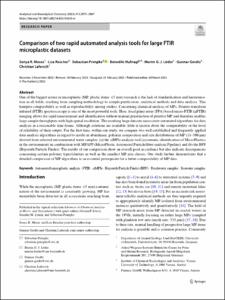| dc.contributor.author | Moses, Sonya R. | |
| dc.contributor.author | Roscher, Lisa | |
| dc.contributor.author | Primpke, Sebastian | |
| dc.contributor.author | Hufnagl, Benedikt | |
| dc.contributor.author | Löder, Martin G. J. | |
| dc.contributor.author | Gerdts, Gunnar | |
| dc.contributor.author | Laforsch, Christian | |
| dc.date.accessioned | 2023-07-10T20:45:37Z | |
| dc.date.available | 2023-07-10T20:45:37Z | |
| dc.date.issued | 2023 | |
| dc.identifier.citation | Moses, S.R., Roscher, L., Primpke, S. et al. (2023) Comparison of two rapid automated analysis tools for large FTIR microplastic datasets. Analytical and Bioanalytical Chemistry, 415, pp.2975–2987. DOI: https://doi.org/10.1007/s00216-023-04630-w | en_US |
| dc.identifier.uri | https://repository.oceanbestpractices.org/handle/11329/2314 | |
| dc.description.abstract | One of the biggest issues in microplastic (MP, plastic items <5 mm) research is the lack of standardisation and harmonisation
in all fields, reaching from sampling methodology to sample purification, analytical methods and data analysis. This
hampers comparability as well as reproducibility among studies. Concerning chemical analysis of MPs, Fourier-transform
infrared (FTIR) spectroscocopy is one of the most powerful tools. Here, focal plane array (FPA) based micro-FTIR (μFTIR)
imaging allows for rapid measurement and identification without manual preselection of putative MP and therefore enables
large sample throughputs with high spatial resolution. The resulting huge datasets necessitate automated algorithms for data
analysis in a reasonable time frame. Although solutions are available, little is known about the comparability or the level
of reliability of their output. For the first time, within our study, we compare two well-established and frequently applied
data analysis algorithms in regard to results in abundance, polymer composition and size distributions of MP (11–500 μm)
derived from selected environmental water samples: (a) the siMPle analysis tool (systematic identification of MicroPlastics
in the environment) in combination with MPAPP (MicroPlastic Automated Particle/fibre analysis Pipeline) and (b) the BPF
(Bayreuth Particle Finder). The results of our comparison show an overall good accordance but also indicate discrepancies
concerning certain polymer types/clusters as well as the smallest MP size classes. Our study further demonstrates that a
detailed comparison of MP algorithms is an essential prerequisite for a better comparability of MP data. | en_US |
| dc.language.iso | en | en_US |
| dc.rights | Attribution 4.0 International | * |
| dc.rights.uri | http://creativecommons.org/licenses/by/4.0/ | * |
| dc.subject.other | Fourier-transform infrared (FTIR) spectroscocopy | en_US |
| dc.subject.other | Automated microplastic analysis | en_US |
| dc.subject.other | siMPle | en_US |
| dc.subject.other | Bayreuth Particle Finder (BPF) | en_US |
| dc.subject.other | Freshwater samples | en_US |
| dc.subject.other | Seawater samples | en_US |
| dc.title | Comparison of two rapid automated analysis tools for large FTIR microplastic datasets. | en_US |
| dc.type | Journal Contribution | en_US |
| dc.description.refereed | Refereed | en_US |
| dc.format.pagerange | pp.2975–2987 | en_US |
| dc.identifier.doi | https://doi.org/10.1007/s00216-023-04630-w | |
| dc.subject.parameterDiscipline | Anthropogenic contamination | en_US |
| dc.subject.dmProcesses | Data analysis | en_US |
| dc.bibliographicCitation.title | Analytical and Bioanalytical Chemistry | en_US |
| dc.bibliographicCitation.volume | 415 | en_US |
| dc.description.sdg | 14.a | en_US |
| dc.description.maturitylevel | Mature | en_US |
| dc.description.methodologyType | Method | en_US |
| dc.description.methodologyType | Specification of criteria | en_US |
| obps.contact.contactname | Sebastian Primpke | |
| obps.contact.contactemail | sebastian.primpke@awi.de | |
| obps.resourceurl.publisher | https://link.springer.com/article/10.1007/s00216-023-04630-w | |
 Repository of community practices in Ocean Research, Applications and Data/Information Management
Repository of community practices in Ocean Research, Applications and Data/Information Management

